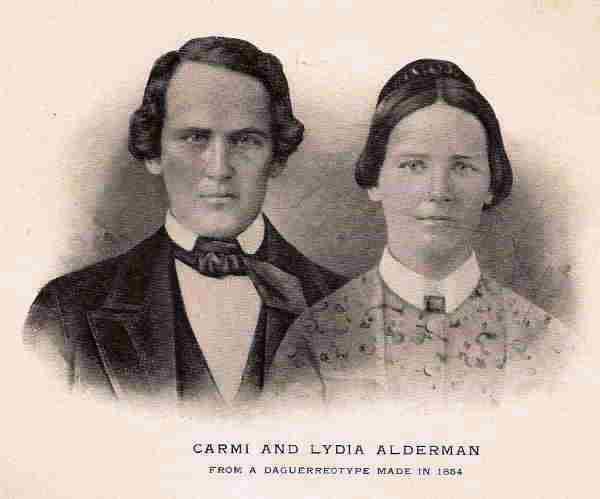Loss leads to love and a life in Letart


Author Barbara Lieberman said, “One does not seek love . . . . It should find you all on its own.” That is most certainly the case for Carmi Alderman who found his way from Morgan County to a life, love, and Letart Falls.
Carmi Alderman was born April 21, 1826, in Morgan County, Ohio. His parents Hosea and Hannah were both of Puritan origin. They moved to Morgan County from Central New York with several members of their extended families and settled in the region in various places. The name Carmi is of biblical origin. In Genesis 46:9 it is noted that Carmi is last named of the four sons of Ruben, and ironically, ancestry.com says that Carmi Alderman was the 4th son of eight children born to Hosea and Hannah.
It’s noted in Edgar Ervin’s Pioneer History of Meigs County that Carmi was a great reader and had planned for a college education. Unfortunately, at the age of 17, Carmi’s father Hosea passed away on October 21, 1843. As if that weren’t tragic enough, Carmi’s brother Ira passed away 6 days later, and less than two months after that, his brother, Asahela, passed away on December 15th. These events led Carmi to give up on his aspirations of a college career. Within the next year or so, he began a short lived career in teaching and attended Ohio University on an irregular basis.
According to a letter Carmi wrote at the age of 70 referencing the fall of 1846, a happy change came into his life at that time.
In the fall of 1846 I visited my mother’s brother, Rev. Isaac Reynolds, who then lived at Racine, Ohio. My cousin Kit [Isaac Reynolds’ daughter] as she was familiarly called, took me with her to the home of Moses E. Sayre, a mile below Letart to get some peaches, and to have a good time with her friend, Lydia Sayre. I suppose the peaches were pretty and good, but I soon lost interest in them for the greater attraction of the girl who was so pleasantly entertaining us. Lydia was her real self; for, by misunderstanding a former remark of my cousin [Kit] she [Lydia] thought I was married; therefore there was nothing artificial about her.
When we returned to Racine, I asked many carefully-guarded questions about the girl I saw under the peach tree, and the family of which she was a part. My aunt said that the girl was worth her weight in gold, and I thought she told the truth. Visions of future happiness took the place of sleep most of the night, and in the morning I asked my uncle [Isaac Reynolds] if he thought I could get a school at Letart. He said he thought I could, and gave me an introduction to the directors, with whom I engaged for a 4 months’ school, after Lydia had given me to understand she was willing to form an acquaintance.
And on the 6th of May [1847] following 8 months after our first meeting, she became my wife. I have never doubted the hand of Providence in this love affair. The love that began under a peach tree, more than fifty years ago, has increased in power and we think will not only endure to end life’s journey, but be more intense and enjoyable when we meet in the Paradise of God.

After marrying Lydia, Carmi began a life as a merchant in Letart that lasted 12 years. At this time, shopkeepers had to travel to get their merchandise. Things like traveling salesmen and sample shipments didn’t exist; no railroad was anywhere near Letart; steamboats could go for months without running due to water conditions. On top of these hurdles, the closest bank was in Pomeroy and most currency exchanged at this time was silver and gold. However, Carmi was determined to bring the best goods possible to Letart. Traveling east to Baltimore, buying large stocks of goods, and then shipping them by rail to Wheeling and later to Parkersburg with the advancement of railroads. From Wheeling, goods were sent downriver via flatboat to Letart. Sometimes when possible, Carmi would travel west to Cincinnati and have the goods shipped upriver via steamboat.
After the start of the Civil War, Carmi Alderman was named postmaster of Letart. There were several copperheads [note: copperhead is a term used for southern sympathizers living in the north during the Civil War] living in Letart who were insistent of letting Confederate letters pass through his post office. He refused. Living also as a minister and a member of the Abolitionist party, he hated slavery, which brought him bitter persecution. Eventually the refusal of allowing confederate letters to pass resulted in threats on, and a plot to take, his life. After discovering this, he decided it was best to move.
Carmi moved his family back to his home in Morgan County and eventually tried to open a business in Steubenville, Ohio, in Jefferson County. Not only an Abolitionist, but with his rigorous religious upbringing he was led to support the temperance movement. Seeing the amount of saloons in Jefferson County, Carmi decided to relocate finally to Ironton, Ohio.
It’s noted in Ervin’s Pioneer History of Meigs County that most of the land in Ironton at this time was owned by “church people” and that any transfer of a deed was on the understanding that “no saloon should ever be operated on the real estate and that no alcoholic beverages should be sold or consumed.” The Ohio Supreme Court eventually ruled this unconstitutional and the above was stricken from all deeds.
Carmi’s wife Lydia died on August 24, 1898. It appears Carmi grieved himself to death: he died 58 days later on October 25, 1898. They are both buried in Letart Falls Cemetery. According to the book The Sayre Family: Another 100 Years, Volume 3, Carmi and Lydia both shared the same birthdate of April 21, 1826. They were married on May 6, 1847; Carmi and Lydia eventually had 4 children; Electa Evelyn Alderman, born on 8/2/1849, America Alderman, born 4/8/1864, Nettie May Alderman, born 5/6/1867 (Carmi and Lydia’s 20th wedding anniversary), and their only son, Carmi Benji Alderman, born 6/15/1868.
As the old Ohio flows….









